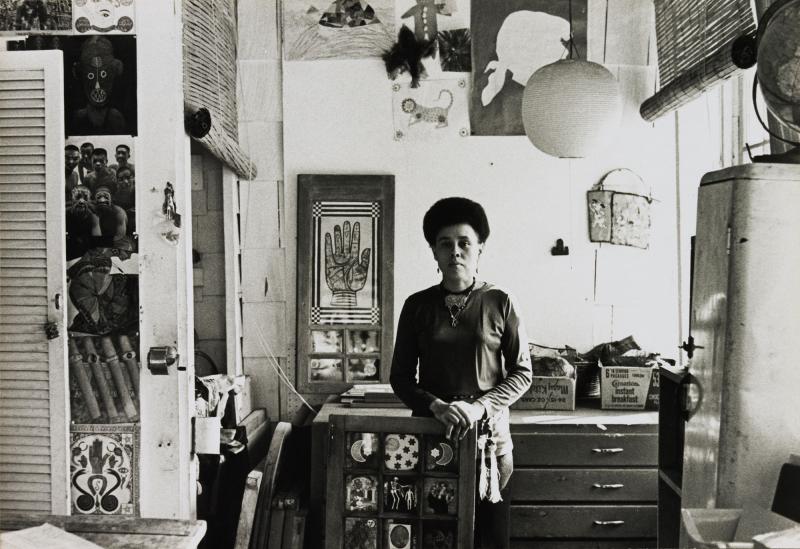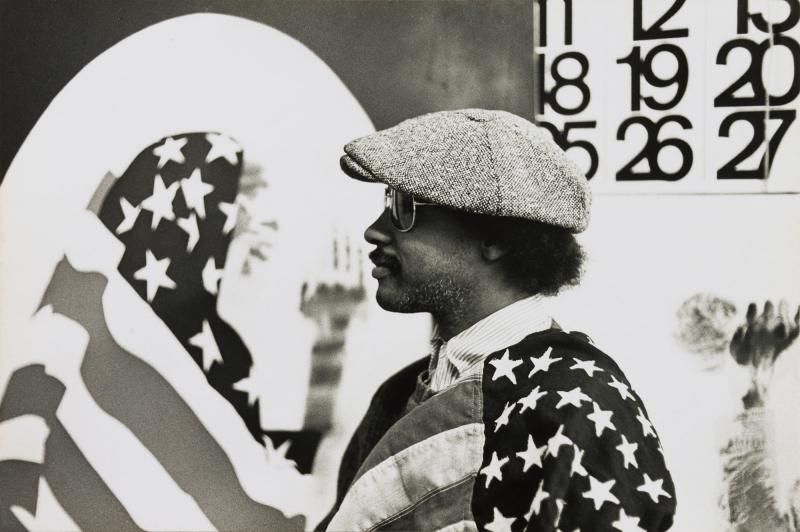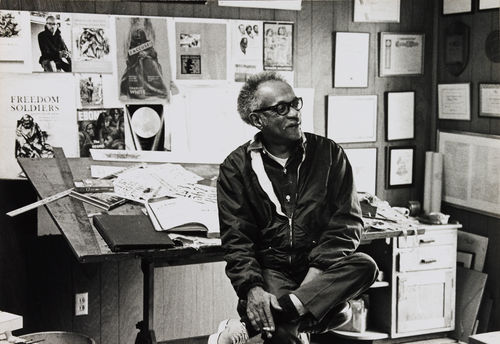Black Art in L.A.
In the portrait of David Hammons, the artist is seen in profile, wearing a cap and sunglasses with an American flag draped over his shoulder (fig. 5). He faces Pray for America, his 1969 body print that shows him with his hands raised in prayer, his head and body covered by the graphic Stars and Stripes of the American flag. The sight of a black man wrapped in an American flag may appear innocuous by standards today, but at the time it was considered controversial and irreverent. Indeed, Cecil Fergerson recounts that the piece nearly cost the Los Angeles County Museum of Art (LACMA) the sponsorship of Bank of America and that when deciding on an acquisition of a Hammons work for its collection, the museum opted for Injustice Case (1970). Its representation of a black man bound, gagged, and tied to a chair was a more palatable option, despite its explicit critique.# Nakamura deftly and simply encapsulates this controversy in his portrait, underscoring awareness of the ensuing conflicts in the realm of representation.
Collectively, Nakamura's photographs present a rich and nuanced portrait of black artists in L.A., simultaneously demystifying the artistic process and conveying seriousness, dignity, and perseverance in contrast to the often negative media depiction of blacks. This was, after all, only five years after the Watts uprising. The studio visit has long been seen as a key to unlocking an artist's ideas and intention. These photographs reproduce that process and, more important, visualize black art making in its full range and diversity. Creativity was not the sole domain of white artists exhibiting in La Cienega galleries or at the newly created LACMA in Hancock Park, a refrain I heard repeatedly as a child from my father as we traversed the city in the family's VW bus.# To underscore this point, on the exhibition panels, each portrait was accompanied by a list of the artist's accomplishments: his or her education, exhibitions, awards, and employment. What is surprising is how long these lists are. Brockman Gallery and Ankrum Gallery, two venues known for showing black artists, appear frequently, but the range of other places demonstrates the degree to which these artists were part of multiple cultural and community networks. In the period before Proposition 13, the state initiative that changed tax codes and had the effect of decimating public education, it is interesting to note how many of the artists in the exhibition taught art at the secondary and college levels. The effect of the panels was to doubly normalize the artists: to demonstrate their ties to the community and to emphasize their standing within the world of art.

This collaboration between Davis, Higa, and Nakamura provides a brief view into the relatedness of Asian American and African American communities in the activism of the 1960s and 1970s. The connection between Black Power and the emergence of the Yellow Power movement is inextricable. The San Francisco Chinatown Red Guards, for instance, employed the same types of titles as those used by the Black Panthers. One of the most penetrating and lucid figures in the Red Guard was Alex Hing, their minister of education. We can also situate these relationships within the broader context of global Third World struggles. The U.S. wars with Korea and Vietnam in which many African Americans fought also formed a backdrop for a wide range of activism in this country. It was not lost on Asian Americans that the United States had been (or was, in the case of Vietnam) at war with people who looked like them. The relative silence that had accompanied the World War II incarceration of Japanese Americans was slowly eroding as young activists sought greater knowledge of and governmental accountability for the mass imprisonment of civilians, one based solely on race. When the nightly news broadcast the Vietnam War into the home, it also brought racist cries of "gook" and "chink" to the forefront, reminding Americans of Asian ancestry that—in the eyes of many and in the social sphere—they remained forever foreign. Nakamura and my father were in the camps as children, respectively at Manzanar in Eastern California and Heart Mountain in Wyoming. They knew all too well the consequences of looking like the enemy.
The year in which these photographs were made, 1970, was a pivotal one for Nakamura. It was the year he sidelined a career in commercial photography and photojournalism to cofound the Asian American media artist collective Visual Communications (VC) with Duane Kubo, Alan Ohashi, and Eddie Wong, and with my father as board chairman. Nakamura had graduated from Art Center (now the Art Center College of Design in Pasadena) with a specialization in photography and in a short amount of time found incredible success. He, along with my father, worked in the studio of Charles and Ray Eames in the late 1960s. Nakamura photographed many influential people and things—some of it idiosyncratic, such as the folk art collection of Alexander Girard—for magazines such as Life, Collier's, and McCall's. It is critical to recognize that although committed to a form of oppositional cultural politics, Nakamura and my father were also educated within and aware of the vanguard of artistic practice. (My father had attended Art Center, Chouinard, and UCLA.) But increasingly Nakamura recognized that the battleground of representation was central to achieving an equitable society.

In the early 1970s Nakamura was enrolled at UCLA's film school and became associated with the new Ethno-Communications program, with which African American filmmaker Charles Burnett and Chicano filmmaker David Garcia, among other artists of color, were also affiliated. Nakamura individually, and with his collaborators at VC, created landmark films exploring the Asian American experience. The morass of Vietnam and the legacy of the World War II incarceration were the crucial backdrop. It is no coincidence that VC's initials also held significance in contemporary parlance for the Viet Cong. Manzanar (1972), which Nakamura produced as part of his MFA thesis, meditatively explores the physical terrain of the former concentration camp site to mine the psychic, political, and emotional toll of the incarceration and its aftermath. The introspective tone, combined with its searing political indictment, has become an influential model of filmic exposition.# Wataridori: Birds of Passage (1974), a documentary produced under the auspices of VC, represents a hallmark of Nakamura's and VC's practice. It focuses on the first-person perspectives and lives of Japanese immigrants and tacitly argues that a fuller picture of the collective American experiences can emerge from individual stories of ordinary people.
As a community-focused educational organization, VC envisioned media as a key vehicle for community empowerment and the development of grassroots critique in photography, audio, film, and video. With VC's founding, Nakamura and his cohorts collected old family photographs to establish a photo archive and organized an influential exhibition about the World War II experience, innovatively designed using cubes for easy transport to and installation at community centers, libraries, and colleges. In 1980 VC produced its first feature-length film, Hito Hata: Raise the Banner, which charts the life of a Japanese immigrant bachelor against the sweep of the twentieth century. (I had the job of making origami paper cranes for a climactic scene and appeared as an extra. My role: Japanese American Girl.)
While Nakamura's stature as a pioneering Asian American filmmaker and community activist is without question, the portraits he made for Black Art in L.A. demonstrate a crucial, if little understood, aspect of the city's cultural terrain. Theorists of Los Angeles have characterized it as a dispersed, disintegrated, and fragmented metropolis, deeply divided socially and too disjointed to generate a vital public life.# Even if one accepts this dystopic vision of the city, there are moments of cross-cultural flowering, often in modest places such as the Da Vinci Gallery at LACC. My father understood this and so did Nakamura. In his photographs of Saar, Outterbridge, and others, the artists are portrayed as commanding their creative space and image, claiming a place for themselves and their art.
In 1970 my father, Kazuo Higa (1935–1994), was the director of the Da Vinci Art Gallery at Los Angeles City College (LACC). He had started teaching art and art history at LACC in 1968 and recognized the important connection for aspiring artists of color between making and seeing art. At that time, black art became a key source of identification not just for African Americans but in the broader Third World sense of people-of-color coalitions. My father invited Alonzo Davis, of the Brockman Gallery, to gather artists who represented the "new black renaissance in art" for the exhibition Black Art in L.A. There were thirteen artists total, of several generations, and all of them men save for Betye Saar.#
Davis emphasized in his introduction that the artists in the exhibition showed unmediated reactions to life: "be it militant, black, love, mother-Africa, dance, sex, humanitarianism, abstract or non-objective." The heterogeneity of this list suggests a freewheeling range of work. Although no checklist survives to specify in what ways those issues were explored, the exhibition panels created by my father hint at the project's richness. He enlisted his good friend and former Marshall High School classmate, photographer and filmmaker Robert A. Nakamura (b. 1937), to make portraits of the artists in their studios, which, along with a biographical list of their accomplishments, formed the exhibition's interpretive frame.

Over a two-day period my father and Nakamura drove across Los Angeles to meet and photograph the artists. These photographs were taken in the early part of Nakamura's career, before he made his mark as a filmmaker. Nakamura's photographs attest to both the provocative presence of the artists in the exhibition and his skill at art directing his subjects to emphasize aspects of their personality and art. The simple act of photographing black artists cannot be underestimated in a period when representations in the mainstream media were nearly nonexistent. Nakamura exquisitely crafted the mise-en-scène to interpret the art. His photographs also reveal something significant about the conception of the artist as a role model. All of the photographs depict the artist working—not as an isolated, lofty practitioner, but as someone with whom people can identify. The images show creativity happening in the studio, articulating an identity outside the dominant cultural institutions. It is noteworthy that many of these artists went to LACC, which, alongside other community colleges in the city, was important both as an educational institution and as a place for activism.
In Nakamura's portrait of John Outterbridge, the artist wears a paint-covered smock in his messy garage studio, surrounded by art, tools, and stuff (fig. 1). Noah Purifoy gazes off-camera with a dreamy look (fig. 2). Charles White sits at his drafting table, cigarette in hand, amid posters of his past shows and various diplomas, certificates, and proclamations that attest to his stature in the world of art (fig. 3). The photograph of Betye Saar shows her in her first studio: the sun porch of her home (fig. 4). Her kitchen table and refrigerator are visible in the foreground, while her kids' drawings appear on the back wall—perhaps one of the first public displays of daughters Alison and Lezley Saar's art. Most significant, Nakamura's photograph shows two of Saar's key early works: View from the Palmist Window (1966) and Black Girl's Window (1969), which mark her transition from a primarily printmaking practice to one of collage and assemblage.
The artists in the exhibition were Dan Concholar, Alonzo Davis, Dale Davis, Marion Epting, David Hammons, Marvin Harden, John Outterbridge, William Pajaud, Noah Purifoy, John Riddle Jr., Betye Saar, Van Slater, and Charles White.
Cecil Fergerson, interview by Karen Anne Mason, August 12, 1994, African American Artists of Los Angeles, Oral History Program, University of California, Los Angeles, transcript, pp. 467–68, Charles E. Young Research Library, Department of Special Collections, UCLA. The man in Injustice Case was meant to represent Black Panther Bobby Seale, who was bound and gagged during his 1968 trial.
For activists such as my father, the establishment of LACMA as a separate institution from the Los Angeles Museum of History, Science and Art and its move from Exposition Park in Central L.A. to its new location in Hancock Park, which was then considered to be on the west side of the city, was a sad example of cultural resources being taken from communities of color and transferred to elite, primarily European American neighborhoods. Additionally, at the time of the split, the art of non-Western cultures was still considered within the realm of "natural history" rather than art, further evidence of cultural myopia and an implicit racism.
In 1969 Nakamura and my father joined a group of former inmates and activists for the first official pilgrimage to Manzanar. For more on this event and its significance, see Pilgrimage (2007), directed by Bob's son Tadashi Nakamura.
Robert Fogelson, The Fragmented Metropolis: Los Angeles, 1850–1930 (Berkeley: University of California Press, 1983).






